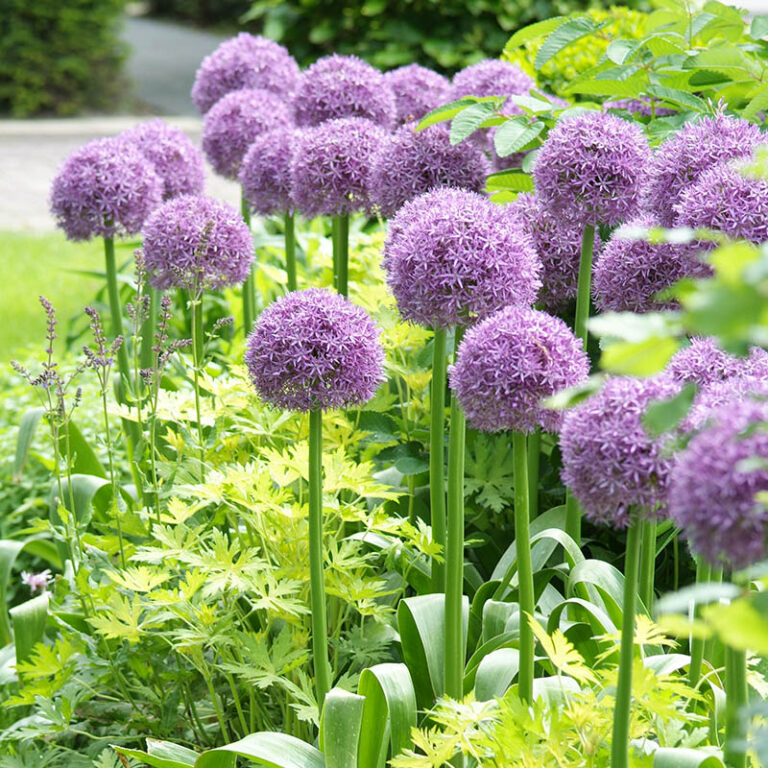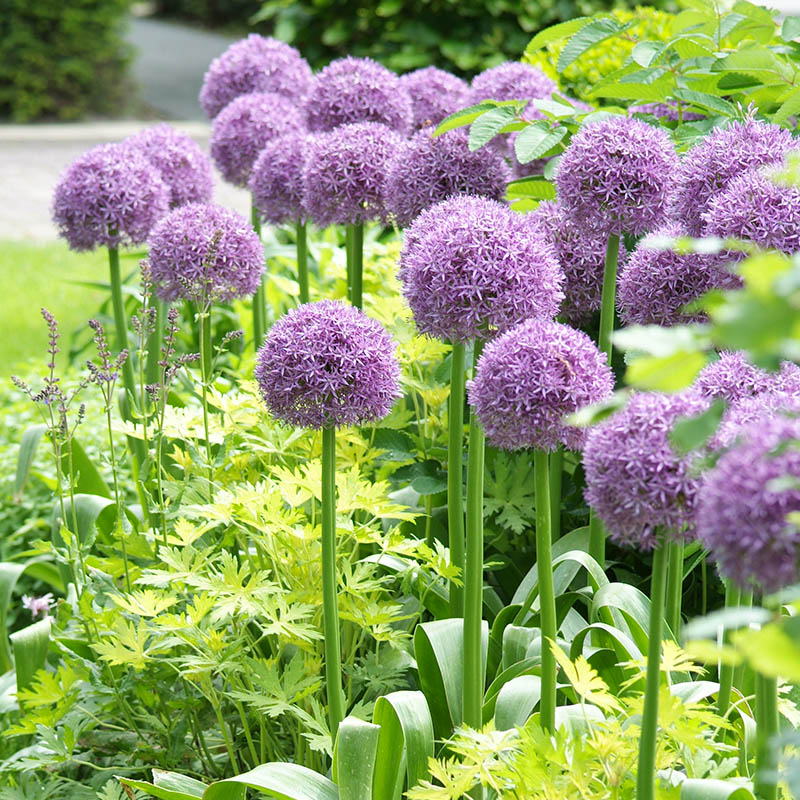When to Plant Allium Bulbs for Optimal Growth
Planting allium bulbs at the right time is crucial for optimal growth and blooming. While many gardeners swear by planting allium bulbs in the fall, others wonder if they can plant them in the spring. The answer is yes, but it’s essential to understand the pros and cons of each planting season. In warmer climates, spring planting can be beneficial, as the bulbs have a chance to establish themselves before the heat sets in.
In general, allium bulbs can be planted in the spring as soon as the soil can be worked. This is usually around late March to early May, depending on the specific climate and region. However, it’s crucial to note that spring-planted allium bulbs may not bloom as profusely as those planted in the fall. This is because the bulbs have a shorter period to establish themselves before the heat of summer.
On the other hand, planting allium bulbs in the fall (around September to November) allows them to establish a strong root system over the winter, resulting in more vigorous growth and blooming in the spring. Fall planting also gives the bulbs a chance to naturalize, or multiply, which can lead to a stunning display of blooms in subsequent years.
So, can you plant allium bulbs in the spring? Absolutely. But it’s essential to weigh the pros and cons and consider your specific climate and region. If you do decide to plant in the spring, make sure to choose a variety that is known to perform well in warmer temperatures, and provide the bulbs with the right conditions to thrive.
How to Plant Allium Bulbs in the Spring for Success
Planting allium bulbs in the spring requires careful planning and attention to detail. To ensure success, follow these step-by-step instructions:
**Step 1: Prepare the Soil**
Before planting, prepare the soil by loosening it to a depth of about 12 inches. Add a 2-inch layer of compost or well-rotted manure to improve soil fertility and drainage. If your soil is heavy clay or sandy, mix in some organic matter to improve its structure.
**Step 2: Choose the Right Location**
Allium bulbs prefer full sun to partial shade, so choose a location that receives at least 6 hours of direct sunlight per day. Also, ensure the area is well-drained, as allium bulbs are prone to rot in waterlogged soil.
**Step 3: Plant at the Correct Depth**
Plant allium bulbs at a depth of 2-3 times their height, depending on the variety. For example, if the bulb is 2 inches tall, plant it 4-6 inches deep. Space the bulbs 3-6 inches apart, depending on the variety and desired density.
**Step 4: Water and Mulch**
After planting, water the bulbs well to settle the soil. Apply a 2-inch layer of mulch, such as straw or bark chips, to retain moisture and suppress weeds.
By following these steps, you can successfully plant allium bulbs in the spring and enjoy their beautiful blooms in late spring and early summer. Remember to plant at the right time for your climate, and don’t hesitate to ask for advice if you’re unsure about any aspect of the process.
Choosing the Right Allium Varieties for Spring Planting
When it comes to planting allium bulbs in the spring, choosing the right variety is crucial for success. While many allium varieties can be planted in the spring, some perform better than others in warmer climates. Here are some popular allium varieties that thrive when planted in the spring:
**’Purple Sensation’**: This variety is known for its vibrant purple flowers that bloom in late spring. It’s a great choice for spring planting, as it’s relatively low maintenance and can tolerate warmer temperatures.
**’Globemaster’**: With its large, globe-shaped flowers, ‘Globemaster’ is a stunning addition to any spring garden. It’s a bit more sensitive to temperature fluctuations, but with proper care, it can thrive in spring-planted gardens.
**’Mount Everest’**: This variety is known for its pure white flowers that bloom in early summer. It’s a great choice for spring planting, as it’s relatively disease-resistant and can tolerate a range of soil conditions.
**’Christophii’**: With its delicate, pinkish-purple flowers, ‘Christophii’ is a beautiful addition to any spring garden. It’s a bit more sensitive to temperature fluctuations, but with proper care, it can thrive in spring-planted gardens.
When choosing an allium variety for spring planting, consider factors such as bloom time, flower color, and growth habits. By selecting the right variety for your climate and garden conditions, you can enjoy a stunning display of allium blooms in the spring.
Preparing the Soil for Spring Allium Planting
Before planting allium bulbs in the spring, it’s essential to prepare the soil to ensure optimal growth and blooming. Here are some tips to help you prepare the soil for your allium bulbs:
**Add Organic Matter**: Allium bulbs thrive in well-draining, fertile soil. Add a 2-inch layer of compost or well-rotted manure to the soil to improve its structure and fertility. This will also help to retain moisture and suppress weeds.
**Adjust pH Levels**: Allium bulbs prefer a slightly acidic to neutral soil pH, ranging from 6.0 to 7.0. If your soil is too alkaline or acidic, adjust the pH levels by adding lime or sulfur, respectively.
**Remove Weeds and Debris**: Clear the area of any weeds, debris, or rocks that could compete with your allium bulbs for water and nutrients. This will also help to prevent pests and diseases from taking hold.
**Loosen the Soil**: Loosen the soil to a depth of about 12 inches to allow for good drainage and root growth. This will also help to prevent waterlogged soil, which can lead to rot and other problems.
**Check for Nutrient Deficiencies**: Allium bulbs require a balanced diet of nutrients to grow and bloom well. Check your soil for nutrient deficiencies and add fertilizers as needed. A balanced fertilizer with a ratio of 10-10-10 (nitrogen-phosphorus-potassium) is a good starting point.
By following these tips, you can create a fertile and well-draining soil environment that will support the growth and blooming of your allium bulbs. Remember to plant your allium bulbs at the right time for your climate, and don’t hesitate to ask for advice if you’re unsure about any aspect of the process.
Caring for Allium Bulbs After Spring Planting
After planting allium bulbs in the spring, it’s essential to provide them with the right care to ensure optimal growth and blooming. Here are some tips to help you care for your allium bulbs:
**Watering**: Allium bulbs need consistent moisture, especially during the first growing season. Water them regularly, but avoid overwatering, which can lead to rot and other problems.
**Fertilizing**: Feed your allium bulbs with a balanced fertilizer in the spring, when the foliage emerges. Avoid high-nitrogen fertilizers, which can promote weak growth and reduce blooming.
**Deadheading**: Remove the flower heads as soon as they finish blooming, to encourage the bulb to focus its energy on re-growing and storing energy for next year’s bloom.
**Allowing Foliage to Die Back**: After blooming, allow the foliage to die back naturally, which can take several weeks to a few months. This will help the bulb to store energy for next year’s bloom.
**Pest and Disease Control**: Keep an eye out for pests and diseases, such as aphids, slugs, and snails, which can damage the bulbs and foliage. Use organic or chemical controls as needed to prevent infestations.
By following these care tips, you can help your allium bulbs to thrive and bloom beautifully in the spring. Remember to plant your allium bulbs at the right time for your climate, and don’t hesitate to ask for advice if you’re unsure about any aspect of the process.
Common Challenges When Planting Allium Bulbs in the Spring
While planting allium bulbs in the spring can be a rewarding experience, there are some common challenges that may arise. Here are some of the most common issues and their solutions:
**Pests**: Slugs, snails, and aphids can be a problem for allium bulbs, especially in the spring. Use organic or chemical controls as needed to prevent infestations.
**Diseases**: Fungal diseases such as botrytis and rust can affect allium bulbs, especially in wet weather. Remove infected foliage and flowers, and treat with fungicides if necessary.
**Extreme Weather Conditions**: Allium bulbs can be sensitive to extreme weather conditions such as heavy rainfall, drought, and high winds. Provide support for tall varieties, and mulch around the base of the plants to retain moisture and suppress weeds.
**Soil-Borne Problems**: Soil-borne problems such as nematodes and fungal diseases can affect allium bulbs. Use crop rotation and soil sterilization to prevent these problems.
**Rodent Damage**: Rodents such as mice and voles can damage allium bulbs, especially in the spring. Use physical barriers such as copper mesh or hardware cloth to prevent damage.
By being aware of these common challenges and taking preventative measures, you can minimize the risks and ensure a successful spring planting of allium bulbs.
Combining Allium Bulbs with Other Spring-Blooming Flowers
Allium bulbs can be combined with other spring-blooming flowers to create a stunning garden display. Here are some suggestions for complementary flowers that pair well with allium bulbs:
**Tulips**: Tulips and allium bulbs have a similar bloom time, making them a great combination. Try pairing ‘Purple Sensation’ allium bulbs with ‘Ballerina’ tulips for a beautiful display of purple and pink flowers.
**Daffodils**: Daffodils and allium bulbs have a similar growth habit, making them a great combination. Try pairing ‘Globemaster’ allium bulbs with ‘Mount Hood’ daffodils for a beautiful display of white and yellow flowers.
**Hyacinths**: Hyacinths and allium bulbs have a similar bloom time, making them a great combination. Try pairing ‘Purple Sensation’ allium bulbs with ‘Blue Jacket’ hyacinths for a beautiful display of purple and blue flowers.
**Grape Hyacinths**: Grape hyacinths and allium bulbs have a similar growth habit, making them a great combination. Try pairing ‘Globemaster’ allium bulbs with ‘Muscari’ grape hyacinths for a beautiful display of blue and white flowers.
When combining allium bulbs with other spring-blooming flowers, make sure to choose varieties that have similar growth habits and bloom times. This will ensure that your garden display is cohesive and beautiful.
Conclusion: Successful Spring Planting of Allium Bulbs
Planting allium bulbs in the spring can be a rewarding experience, but it requires careful planning and attention to detail. By following the tips and guidelines outlined in this article, you can ensure a successful spring planting of allium bulbs.
Remember to choose the right allium variety for your climate and garden conditions, and to plant at the right time for optimal growth and blooming. Prepare the soil properly, and provide the right care and maintenance after planting.
With proper timing, soil preparation, and post-planting care, you can enjoy a stunning display of allium blooms in the spring. Whether you’re a seasoned gardener or just starting out, planting allium bulbs in the spring is a great way to add beauty and interest to your garden.
So, can you plant allium bulbs in the spring? Absolutely With the right knowledge and preparation, you can enjoy a successful and beautiful spring planting of allium bulbs.









